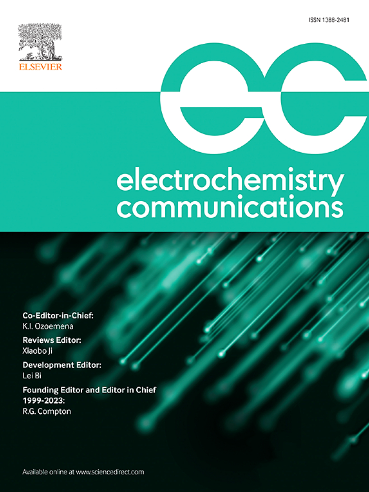PVP燃料固燃合成无序尖晶石LiMn1.5Ni0.5O4正极材料
IF 4.2
3区 工程技术
Q2 ELECTROCHEMISTRY
引用次数: 0
摘要
本研究以金属硝酸盐为氧化剂,以不同用量的聚乙烯吡罗烷酮(PVP)为燃料,采用溶液燃烧法制备了LiMn1.5Ni0.5O4粉体。探讨了PVP含量和煅烧处理对Mn3+比例、形貌和电化学性能的影响。煅烧处理分为两步处理(450℃预处理,800℃煅烧)和一步处理(600℃)。在最低燃料含量下,在600℃下煅烧结晶出具有无序尖晶石结构(Fd3m空间群)的单相LiMn1.5Ni0.5O4粉末。在600℃的煅烧温度下,LiMn1.5Ni0.5O4仍呈现八面体形貌。采用两步法煅烧的LiMn1.5Ni0.5O4粉末具有相当的锂离子存储性能,包括在1C下200次充放电循环后的容量保持率为99%,比容量为110 mAh g−1。本文章由计算机程序翻译,如有差异,请以英文原文为准。

Solution combustion synthesis of disordered spinel LiMn1.5Ni0.5O4 cathode material using PVP fuel
In this research, the LiMn1.5Ni0.5O4 powders were prepared by solution combustion method using metal nitrates as an oxidant and various amounts of polyvinylpyrrolidone (PVP) as fuel. The effects of PVP contents and calcination treatment on the Mn3+proportion, morphology, and electrochemical properties were explored. The calcination treatment included the two-step process (pretreatment at 450 °C and then calcination at 800 °C) and one-step treatment at 600 °C. Single-phase LiMn1.5Ni0.5O4 powders with disordered spinel crystal structure (space group of Fd3m) were crystallized by calcination at 600 °C at the lowest fuel contents. The LiMn1.5Ni0.5O4 particles had octahedral morphology even at the calcination temperature of 600 °C. The LiMn1.5Ni0.5O4 powders calcined using the two-step process exhibited comparable lithium-ion storage performance, including a capacity retention of 99 % following 200 charge/discharge cycles at 1C and a specific capacity of 110 mAh g−1.
求助全文
通过发布文献求助,成功后即可免费获取论文全文。
去求助
来源期刊

Electrochemistry Communications
工程技术-电化学
CiteScore
8.50
自引率
3.70%
发文量
160
审稿时长
1.2 months
期刊介绍:
Electrochemistry Communications is an open access journal providing fast dissemination of short communications, full communications and mini reviews covering the whole field of electrochemistry which merit urgent publication. Short communications are limited to a maximum of 20,000 characters (including spaces) while full communications and mini reviews are limited to 25,000 characters (including spaces). Supplementary information is permitted for full communications and mini reviews but not for short communications. We aim to be the fastest journal in electrochemistry for these types of papers.
 求助内容:
求助内容: 应助结果提醒方式:
应助结果提醒方式:


